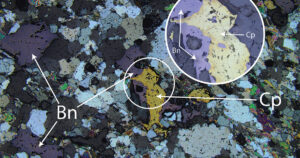The generation of Earth’s magnetic field occurs within the Earth’s interior, in a layer known as the outer core. this magnetic field is absolutely vital as it protects the Earth against cosmic radiation and from the charged particles emitted by the Sun, also known as solar wind. it also provides us with the handy basis for navigation with a compass.
The interaction between the solar wind and the Earth’s magnetic field forms a giant bubble of magnetism called the ‘magnetosphere’ which, to a large extent, deflects the high-velocity Sun particles, hence preventing them from stripping the atmosphere and protecting us, ensuring that our satellites, power grids and jet liners for instance, are safe. Due to the solar winds, the shape and size of the Earth’s magnetic field is, however, continually changing.
The Earth behaves as if a giant bar magnet were more or less aligned along its axis of rotation. However, a compass needle will point to magnetic north rather than true north and the angle between the two is called ‘declination’ which can vary from place to place and over time. For instance at the equator, the compass needle rests horizontally whereas at the magnetic poles, it points vertically. This is called ‘magnetic inclination’.
Also, natural magnets lose their magnetism at a temperature known as the Curie point which is about 770°C for iron. It is estimated that the temperature of the Earth’s iron-nickel core is 5,500°C which is way higher than the Curie point: this means that there is in fact no magnet in the centre of the Earth.
Scientists believe that the field is formed electromagnetically through a process of heat circulation in the molten outer regions of the Earth’s metallic core (there, the convective energy from the slow-moving molten iron is converted to electrical and magnetic energy), Earth’s rotation and the Sun’s magnetic field. It appears that the core is host to ‘magnetic domains’ that combine to form the Earth’s total magnetic field. These domains slowly shift position and cause the magnetic poles to move, hence changing the ‘magnetic declination’.
Scientists have gathered information about the strength and direction of Earth’s magnetic field in the past as rocks record the orientation of the field when they form. The magnetic field preserved in rocks is call paleomagnetism (or fossil magnetism) and offers knowledge about the Earth’s evolution throughout the entire geological history. The best recorders or paleomagnetism are volcanic rocks, especially basalt.
In the 1950s, when paleomagnetism was in its infancy, routine measurements led to the discovery that the Earth’s magnetic field had periodically reversed, with the north and south magnetic poles switching places. The field, when aligned as it is now, became known as ‘normal polarity periods’ and the opposite alignment became ‘reversed polarity periods’. The cause of magnetic reversal is not known and the processes are uncertain: it seems that the magnetic domains in the core change polarity individually. This results in the weakening of the field, which disappears and gradually reforms and strengthens as more domains assume the new polarity direction.
Currently the Earth’s magnetic field is weakening at a disturbing rate, especially over southern Africa. Since measurements started in the 1940s the field has weakened by about 20% and it is believed that a magnetic domain has already reversed its polarity. However, compasses still point north as the global field continues to dominate. The last polar reversal is believed to have taken place about 780,000 years ago and it is therefore inferred that a polar reversal may be commencing currently, as we speak.
References/Sources
http:// https://science.nasa.gov/science-research/planetary-science/earths-magnetosphere/
https://www.swpc.noaa.gov/phenomena/earths-magnetosphere/
US Geological Survey
Terrence McCarthy (2009) How on Earth?










